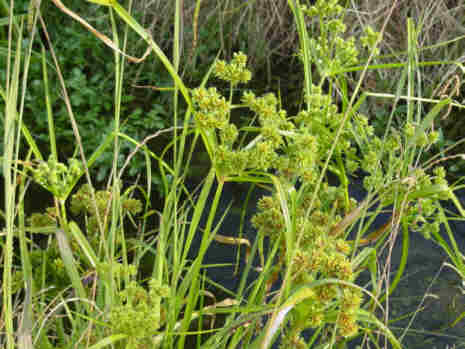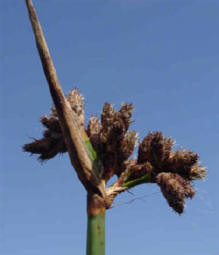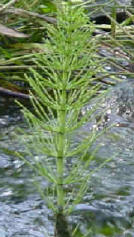 |
MISSION CREEK
AQUATIC PLANTS
NATIVE |
|
|
Plants in a stream corridor
can be diverse and abundant. The water from the stream
provides excellent conditions for both land and aquatic
plants. In the stream you would find aquatic plants that are
adapted to being surrounded by water. The zone adjacent to
the stream, known as the riparian zone, can sustain land
plants whose roots can tap the moist soil from the stream.
Along Mission Creek there are very old trees, some oaks may be
300 years old. In the restored area, plants were chosen that
represent Fremont when the Ohlone Indians roamed this area.
|
Brassicaceae (Mustard Family) |
|
 Watercress Watercress
Rorippa nasturtium-aquaticum
NATIVE
Watercress
has deeply divided leaves that lie along the surface of the water
bordering slow-moving creeks. Its showy white flowers grow above
the water. Both the leaves and flowers have a strong peppery flavor
and are used in salads, soups, and sandwiches. It was valued by
early Californians as a rare source of winter vitamins. Watercress
should not be collected from the wild unless the water in which it
grows is free from pollutants and uncontaminated by cattle and
sheep.
|
|
Cyperaceae
(Sedge Family) |
|
 Flat
Sedge Flat
Sedge
Cyperus eragrostis
NATIVE
Flat sedges range in height
from .4 – 1 meter, and tolerates pH between 5 and 9. It is
sometimes referred to as umbrella sedge. It is found close to the
water’s edge because it prefers wet soil. This perennial has
greenish-yellow flowers that are clustered in spikelets borne on
round heads. The stems are slightly triangular in cross sections.
It is an invasive native weed. Flat sedge grows at the edges of
ponds and slow-moving creeks. |
|
 Hardstem
Bulrush, Native Tule Hardstem
Bulrush, Native Tule
Scirpus acutus var. occidentalis
NATIVE
The flowers
occur in dense spikelets borne at the top of the stem. The Ohlone
Indians bound bundles of tules together to make boats that were used
in hunting and fishing along San Francisco Bay. Air chambers in the
hollow stems kept the boats afloat. Long cylindrical stems
range from 1.5
to 2.4 meters tall. Leaves have slender, v-shaped blades. Flowers
are arranged as spikelets and resemble orange brown scales.
Reproduction is usually from underground stems. |
|
Equisetaceae
(Horsetail Family) |
|
 Horsetail Horsetail
Equisetum arvense
NATIVE
Horsetails are ancient, primitive plants that have survived nearly
unchanged for three hundred million years. They grow in swampy and
moist areas. They have jointed, ribbed, bright green stems topped
by small dark cones that produce tiny spores instead of seeds.
Horsetails are sometimes called scouring rushes because they take up
silica, which forms hardened branches which was useful to early
inhabits to clean cooking pots. |